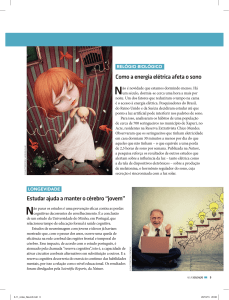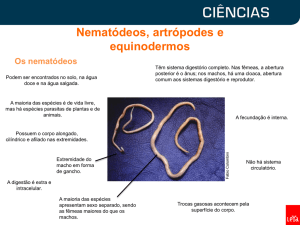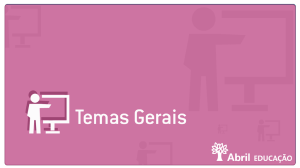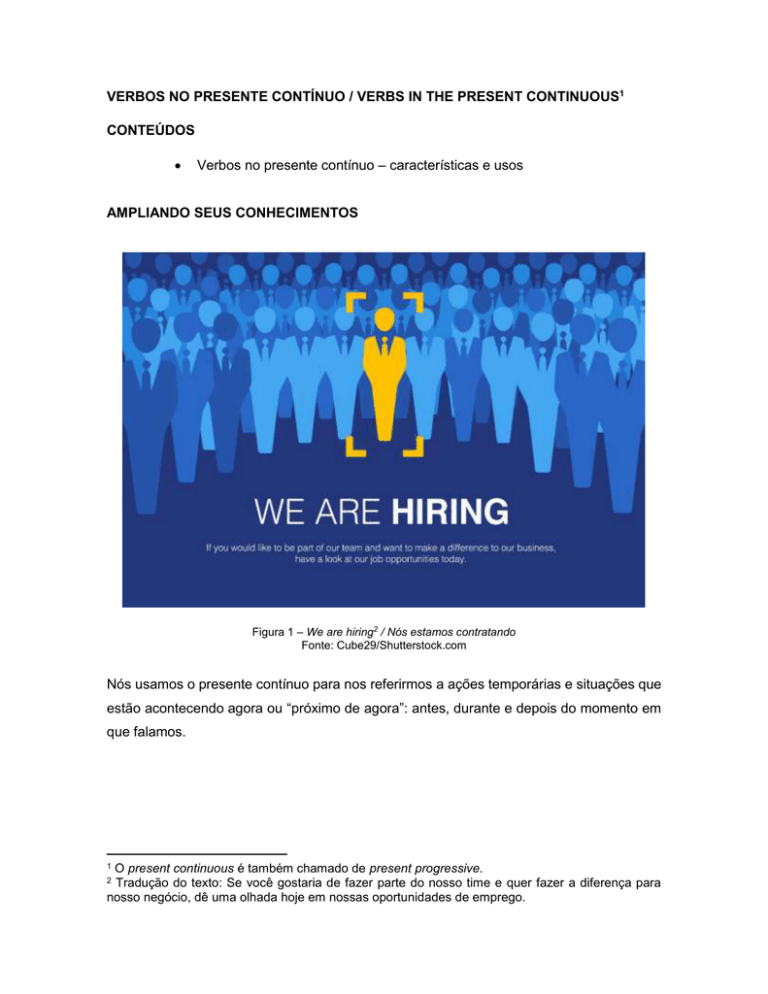
VERBOS NO PRESENTE CONTÍNUO / VERBS IN THE PRESENT CONTINUOUS1
CONTEÚDOS
Verbos no presente contínuo – características e usos
AMPLIANDO SEUS CONHECIMENTOS
Figura 1 – We are hiring2 / Nós estamos contratando
Fonte: Cube29/Shutterstock.com
Nós usamos o presente contínuo para nos referirmos a ações temporárias e situações que
estão acontecendo agora ou “próximo de agora”: antes, durante e depois do momento em
que falamos.
1
O present continuous é também chamado de present progressive.
Tradução do texto: Se você gostaria de fazer parte do nosso time e quer fazer a diferença para
nosso negócio, dê uma olhada hoje em nossas oportunidades de emprego.
2
Exemplos:
Hurry up! We’re all waiting for you!
(Apresse-se! Nós todos estamos esperando por você!)
Why are you crying?
(Por que você está chorando?)
Figura 2 – Present continuous / Presente contínuo
Fonte: Fundação Bradesco
Observe mais alguns exemplos:
My mother is preparing our lunch now.
(Minha mãe está preparando o nosso almoço agora.)
Lia is on vacation. She is getting up very late.
(Lia está de férias. Ela está levantando-se muito tarde.)
I am carrying a heavy bag.
(Eu estou carregando uma mala pesada.)
Observe a estrutura das formas afirmativa, negativa e interrogativa desse tempo verbal.
Forma afirmativa
SUJEITO +
VERBO TO BE +
VERBO TERMINADO EM
COMPLEMENTO
–ING +
I
am
reading
a book.
(Eu
estou
lendo
um livro.)
He
is
listening
to the radio.
(Ele
está
ouvindo
rádio.)
Forma negativa
SUJEITO +
VERBO
NOT +
VERBO TERMINADO EM
COMPLEMENTO
–ING +
TO BE +
I
am
not
reading
a book.
He
is
not
listening
to the radio.
Forma interrogativa
VERBO
SUJEITO +
VERBO TERMINADO EM
COMPLEMENTO ?
–ING +
TO BE +
Am
I
reading
a book?
Is
he
listening
to the radio?
Com o acréscimo do –ing, é importante lembrar que alguns verbos sofrem alteração na
grafia. Vamos ver quais são as regras para acrescentar –ing.
Verbos terminados em -e: elimina-se o -e antes de acrescentar -ing.
Exemplos:
hope – hoping
live – living
Verbos de uma sílaba terminados em consoante precedida de uma única vogal: repetese a consoante final antes de acrescentar -ing.
Exemplos:
stop – stopping
rob – robbing
Verbos de duas sílabas, sendo a segunda tônica, repete-se a consoante final antes de
acrescentar -ing.
Exemplos:
prefer – preferring
control – controlling
Verbos terminados em -y: conserva-se o y, acrescentando-se -ing.
Exemplos:
study – studying
try – trying
Verbos terminados em -ie: substitui-se ie por y antes de acrescentar -ing.
Exemplos:
die – dying (morrer)
lie – lying (mentir ou deitar
ATIVIDADES
1. Relacione as frases com as figuras correspondentes.
a) The woman is sunbathing at a tropical beach.
b) The girl is doing her homework.
c) The teacher is explaining the lesson.
d) The man is swimming.
(
( )
)
Figura 3
Fonte: Pio3/Shuttertstock.com
Figura 4
Fonte: Liderina/Shutterstock.com
(
( )
Figura 5
Fonte: Oleg Gawriloff/Shutterstock.com
)
Figura 6
Fonte: Burlingham/Shutterstock.com
2. Passe as frases do exercício “1” para as formas negativa e interrogativa.
a)
b)
c)
d)
3. Selecione a opção correta do present continuous:
( )
( )
(X)
are working
am working
is working
in the garden now.
I
(
(
(
)
)
)
are watching
am watching
is watching
TV at the moment.
My sister
and I
(
(
(
)
)
)
are reading
am reading
is reading
a magazine now.
She
(
(
(
)
)
)
are playing
am playing
is playing
the guittar.
d)
Listen!
The two
brothers
(
(
(
)
)
)
are singing
am singing
is singing
our favorite song.
e)
Wait a
minute! I
(
(
(
)
)
)
are finishing
am finishing
is finishing
the omelette for us.
Exemplo
Look! Juan
a)
b)
c)
4. Reescreva as frases usando a forma contraída ou a forma regular adequada.
Exemplos:
I’m talking to my sister. (forma contraída)
I am talking to my sister. (forma regular)
He is drinking tea. (forma regular)
He’s drinking tea. (forma contraída)
a) We are playing soccer.
__________________________________________________________________
b) He is opening the window.
__________________________________________________________________
c) I am writing a complaining letter.
__________________________________________________________________
d) She’s crying a lot.
__________________________________________________________________
e) They’re looking in the mirror.
__________________________________________________________________
INDICAÇÕES
Acesse o link a seguir que está disponível no Mapa Curricular do Portal EJ@ e conheça
mais materiais que tratam sobre verbos no present continuous ou presente contínuo em
inglês!
Verbo - Presente Contínuo
REFERÊNCIAS
BRADESCO, Fundação. Present continuous. Estela Garcia da Silveira. 23 nov. 2016. 11h.
SHUTTERSTOCK.COM. BURLINGHAM. Teacher in front of a chalkboard. ID
279446216. Disponível em: <https://www.shutterstock.com/pt/pic-279446216/stock-photoolder-male-teacher-standing-in-front-of-a-chalkboard-in-aclassroom.html?src=B6HQFjadSqE8iXIbGChszg-1-45>. Acesso em: 23 nov. 2016. 13h.
SHUTTERSTOCK.COM. CUBE29. We are hiring. ID 268355753. Disponível em: <
https://www.shutterstock.com/pt/pic-268355753/stock-vector-the-choice-of-the-best-suitedemployee-yellow-human-sign-as-a-symbol-of-chosen-one-by-the-recruiter-hr-job-seekingconcepts.html?src=Ne1xa6dcdOq8P9W_9kv8DA-1-18>. Acesso em: 23 nov. 2016. 13h.
SHUTTERSTOCK.COM. LIDERINA. Girl doing her homework. ID 393144409. Disponível
em: < https://www.shutterstock.com/pt/pic-393144409/stock-photo-profile-of-little-africangirl-writing-at-home.html?src=aUHZgQ_R9Ab9SbAdz9lo9A-1-21>. Acesso em: 23 nov.
2016. 13h.
SHUTTERSTOCK.COM. OLEG GAWRILOFF. Young woman sunbathing at tropical
beach.
ID
380275951.
Disponível
em:
<https://www.shutterstock.com/pt/pic380275951/stock-photo-young-woman-sunbathing-on-lounger-at-tropicalbeach.html?src=l0qqMWDVyUHYBbEJy0eVpg-3-3>. Acesso em: 23 nov. 2016. 13h.
SHUTTERSTOCK.COM. PIO3. Man in the swimming pool. ID 295929080. Disponível em:
<https://www.shutterstock.com/pt/pic-295929080/stock-photo-professional-man-swimmerinside-swimming-pool.html?src=WTD7PCAMtOO0q8-XaSZWdA-1-24>. Acesso em: 23
nov. 2016. 13h.
SWAN, Michael. Practical English Usage. Oxford: Oxford University Press, 2014. 3rd
edition.
GABARITO
1.
(d)
(b)
Figura 3
Fonte: Pio3/Shuttertstock.com
(a)
Figura 4
Fonte: Liderina/Shutterstock.com
(c)
Figura 5
Fonte: Oleg Gawriloff/Shutterstock.com
a) A mulher está tomando sol numa praia tropical.
b) A menina está fazendo a sua lição de casa.
c) O professor está explicando a lição.
d) O homem está nadando.
Figura 6
Fonte: Burlingham/Shutterstock.com
2.
a) The woman is not sunbathing at a tropical beach.
Is the woman sunbathing at a tropical beach?
b) The girl is not doing her homework.
Is the girl doing her homework?
c) The teacher is not explaining the lesson.
Is the teacher explaining the lesson?
d) The man is not swimming.
Is the man swimming?
3.
a)
( )
are watching
I
(X)
am watching
( )
is watching
(Eu estou assistindo à TV neste momento)
TV at the moment.
b)
(X)
are reading
( )
am reading
a magazine now.
( )
is reading
(Minha irmã e eu estamos lendo uma revista agora.)
c)
( )
are playing
She
( )
am playing
(X)
is playing
(Ela está tocando violão.)
My sister
and I
the guittar.
d)
Listen!
(X)
are singing
our favorite song.
The two
( )
am singing
brothers
( )
is singing
(Ouça! Os dois irmãos estão cantando a nossa música favorita.)
e)
Wait a
( )
are finishing
the omelette for us.
minute!
(X)
am finishing
I
( )
is finishing
(Espere um minuto! Eu estou terminando a omelete para nós.)
4.
a) We’re playing soccer.
(Nós estamos jogando futebol.)
b) He’s opening the window.
(Ele está abrindo a janela.)
c) I’m writing a complaining letter.
(Eu estou escrevendo uma carta de reclamação.)
d) She is crying a lot.
(Ela está chorando muito.)
e) They are looking in the mirror.
(Eles estão olhando no espelho.)

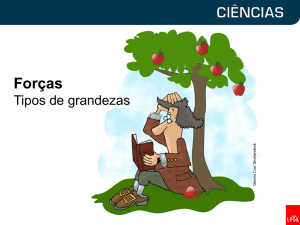
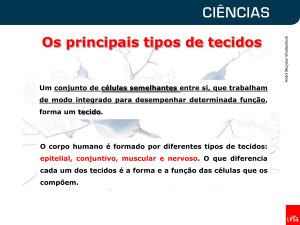
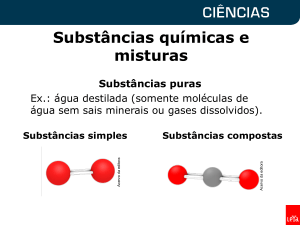
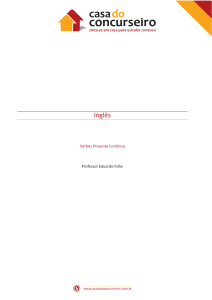
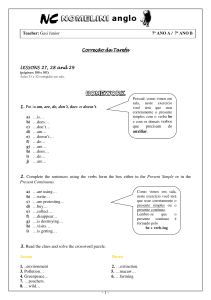
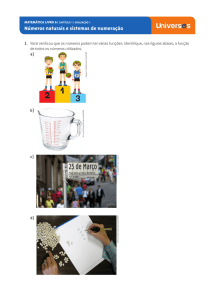
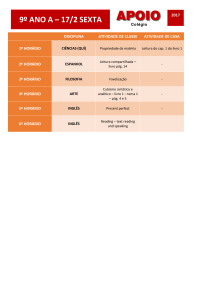

![[1] 22 Data Turma PROFESSOR / DISCIPLINA](http://s1.studylibpt.com/store/data/004886036_1-b8320e9a49af981e1e6084997649e677-300x300.png)
